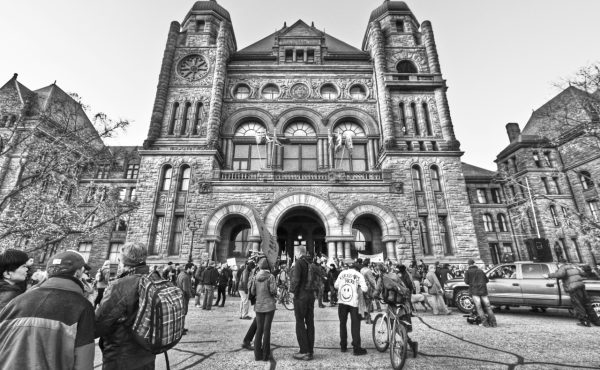
Putting money on the arts
News flash: investing in arts and culture is good for cities! This is the message Greg Reed, board member of the group Business for Arts, delivered to the economic development committee Feb. 21. “Arts and culture funding used to be driven by public money,†Reed said. “Now the conversation starts with: how do we get the private sector involved?â€
His answer: if governments pony up the cash first, the private sector will follow. He gives the example of the SuperBuild fund, the $325 million that the federal and provincial governments forked over to grand cultural institutions. Since $325 million wasn’t nearly enough to fund the ROM’s giant crystal and give the AGO the Frank Gehry treatment, private funders stepped in to fill the gap.
But what about the smaller guys? On the heels of all the hoopla over development in the Queen West Triangle (QWT), I expected at least part of Reed’s presentation to touch on the need to ensure affordable spaces for artists to live and work.
As Reid Henry of Artscape put it when I interviewed him last summer: “Councils typically understand the feeder system for hockey — minor hockey investment can lead to guys in the NHL — but they don’t put the same investment into the feeder system for art.â€
In the art world, the minor league players often get the brush-off. But when I ask chair of the economic development committee Kyle Rae about funding live-work spaces for artists, he makes it sound like old news. “We’ve been doing that for years with our support for Artscape,†he says. As for the QWT, “There have been very few phenomena more beneficial than the shifting of the arts scene across the city,†Rae argues, pointing to the migration Toronto’s arts community has made from Yorkville, to the Annex, to Queen West over the years. “I’m not interested in the talk that West Queen West is the last place it should be. I don’t want this process to stop.â€
That’s quite a different take from the speech he made a couple weeks ago during city council’s debate on whether to appeal the OMB’s decision in the QWT. “When we have a hub or enclave that has developed over the years then you nurture it,†he argued. “This area is just beginning to blossom.â€
The road to prosperity
If Ottawa hands over that 1 per cent of the GST that mayor David Miller has been asking for (which it should), Toronto will receive an additional, and sorely needed, $450 million a year. But according to a report from the Toronto City Summit Alliance, a $0.07-per-kilometre road toll would snag us $700 million, while emission-based vehicle registration could net another $300 million. Considering Toronto’s financial straits (not to mention the world’s environmental ones), why aren’t we pursuing these options more aggressively?




3 comments
There are problems with emission based registration:
1. Generally it’s based on the emission of the car when purchased rather than now – a badly maintained middle-of-the-pack car could end up polluting more than a nominally heavy on gas but well maintained one. DriveClean is a joke – something hardline like the NCT in Ireland might work but there would be riots in the streets.
2. It’s not a pay as you pollute system – fuel tax is. As an aside, I would like to see fuel taxes revised so that GST is replaced by a fixed tax which raises the same amount of money. At present during supply shortages the tax take increases due to price rises which further inflates the price at the pump. Also, the tax take from remote communities is higher because the price of gas is generally higher due to transport costs.
Basically if you are a transit user and also have a well maintained car which is on the heavy side of gas according to the manufacturer label, you get slammed. If you buy an “economical” car but never service it and never take transit, you will pay a lower registration tax. This seems wrong to me.
I really get tired of all the hoopla about support for the arts when what we really get is support for the construction industry.
It’s the programs inside the building — the music, the theatre, the dance, the paintings, the historical retrospectives, etc etc — that people come for. Yes a beautiful building can complement the artistic content. I personally feel that the makeover of Roy Thomson Hall to improve the acoustics was worth ever penny — but without good performances, and the funds to sustain the resident companies, all we get is more buildings but less art.
Steve
This is a very revealing statement. Beneficial for whom? Of course, migrating packs of artists that gentrify areas that were previously extremely depressed benefits loads of people: homeowners, landlords, shop owners, etc. But when the area becomes too gentrified, Kyle Rae reckons it’s time for the artists to move out – really? I know it is incredibly convenient for everyone else, but it seems to me that artists are mostly focused (and should be focused) on making work, instead of breaking in desolate areas of town for the yuppies.